Click on images to enlarge
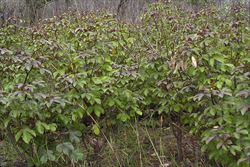
dense infestation (Photo: Chris Gardiner)
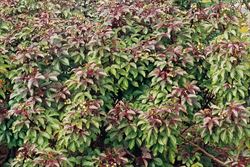
habit in the wet season (Photo: Land Protection, QDNRW)

habit during the dry season (Photo: Chris Gardiner)
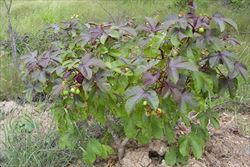
habit (Photo: Chris Gardiner)

thick stems (Photo: Sheldon Navie)
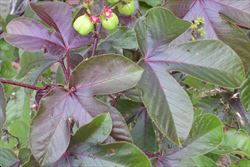
leaves (Photo: Chris Gardiner)

young leaves, flowers and fruit (Photo: Land Protection, QDNRW)
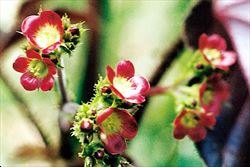
close-up of flowers (Photo: Land Protection, QDNRW)

close-up of fruit and leaf stalks covered in sticky hairs (Photo: Chris Gardiner)

young plant (Photo: Chris Gardiner)
Scientific Name
Jatropha gossypiifolia L.
Synonyms
Adenoropium gossypifolium (L.) Pohl.Jatropha gossypifolia L.
Family
Euphorbiaceae
Common Names
American purging nut, bellyache bush, black physic nut, black physicnut, cotton leaf physic nut, cotton-leaf jatropha, cotton-leaf physic nut, purging nut, red fig-nut flower, wild cassava
Origin
Native to Mexico, the Caribbean (i.e. Antigua and Barbuda, Dominica, Guadeloupe, Puerto Rico, St. Kitts and Nevis and St. Lucia), Central America (i.e. Costa Rica, Honduras and Nicaragua) and tropical South America (i.e. Venezuela, Brazil, Bolivia, Colombia, Ecuador, Peru and Paraguay).
Cultivation
Bellyache bush (Jatropha gossypiifolia) was deliberately introduced into northern Australia as a garden ornamental at some time in the late 1800's.
Naturalised Distribution
This species has a widespread but scattered distribution throughout northern Australia. It is most common in the northern parts of Queensland, the Northern Territory and Western Australia, but is also present in central and south-eastern Queensland and in other parts of the Northern Territory. The most extensive infestations in Queensland exist within the Burdekin River catchment, where its distribution extends from north of Charters Towers to the Burdekin river mouth and back along many of its tributaries, including the catchments of the Bowen, Suttor, Bogie and Belyando Rivers.
Also naturalised in south-eastern USA (i.e. Florida), in Indonesia and Africa, on La Réunion in the Indian Ocean, and on several Pacific Islands (e.g. Hawaii, French Polynesia, Palau, New Caledonia and Guam).
Habitat
This species is most commonly found in drier tropical environments, but is sometimes also naturalised in sub-tropical and semi-arid regions. It is a weed of degraded pastures, open woodlands, monsoon vine forests, grasslands, riparian vegetation, coastal foreshores, roadsides, disturbed sites, waste areas and old or abandoned gardens.
Habit
An upright (i.e. erect) shrub or small tree usually growing 1-3 m tall. but occasionally reaching up to 4 m in height. It usually loses its leaves during the dry season (i.e. it is deciduous).
Distinguishing Features
- an upright shrub or small tree usually growing 0.7-4 m tall.
- its stems are thick and exude a soapy sap when broken.
- its alternately arranged leaves have three or five pointed lobes and are dark reddish-purple when young.
- its small flowers are dark red with yellow centres and are borne in clusters in the upper leaf forks.
- its three-lobed fleshy capsules each contain three seeds.
Stems and Leaves
The older stems are relatively thick and either somewhat succulent or softly woody. These older stems contain a watery or soapy sap. The younger branches are purplish in colour and densely covered in hairs (i.e. they are pubescent).
The alternately arranged leaves (4.5-10 cm long and 5-13 cm wide) have three or five deep spreading lobes (i.e. they are palmately lobed). These leaves are purplish and covered in sticky (i.e. glandular) hairs when immature, but usually turn bright green as they age. The leaf blades are borne on stalks (i.e. petioles) 6-9 cm long which are also covered in sticky (i.e. glandular) hairs. The margins of the leaves are entire, but they are adorned with a line of hairs (i.e. they are ciliate).
Flowers and Fruit
The small flowers are borne in loose branched clusters at the tips of the branches (i.e. in terminal panicles or cymes). The main branch (i.e. peduncle) of each flower cluster is 10-15 cm long, purplish in colour, and covered in sticky (i.e glandular) hairs. There are separate male and female (i.e. unisexual) flowers present in these clusters. The majority of the flowers in the clusters are male (i.e. staminate), and have 8-12 yellow stamens, while the central flower on each branch of the flower cluster is female (i.e. pistillate). In all, there are usually 2-8 female and 27-54 male flowers in each flower cluster. All of the flowers have five deep purple to bright red coloured petals and five small sepals. Flowering occurs throughout the year, but mostly during late summer and autumn.
The fruit is a slightly three-lobed capsule that is slightly hairy (i.e. puberulent). It is oval or oblong in shape (about 12-13 mm long and 10 mm wide) and usually contains three large seeds. These fruit are initially glossy green in colour but turn brown as they mature. The egg-shaped (i.e. ovoid) seeds (7-8 mm long and about 4 mm wide) are orange-brown or dark brown in colour.
Reproduction and Dispersal
This species reproduces mainly by seed, though suckers can also develop from its roots and crown.
Seeds may be spread short distances when they are explosively released, while most long range dispersal probably occurs in water or mud. Native meat ants also play an important role in the short-range dispersal of its seeds.
Environmental Impact
Bellyache bush (Jatropha gossypiifolia) is regarded as an important environmental weed in the Northern Territory, Queensland and the northern parts of Western Australia. It was recently listed as a priority environmental weed in five Natural Resource Management regions, and is even ranked among the top 200 most invasive plant species in south-eastern Queensland.
Of particular concern is the impact that this species has on riparian habitats in semi-arid regions. It these areas it replaces native vegetation and may delay or prevent regeneration of native shrubs and trees. Extensive bellyache bush (Jatropha gossypiifolia ) thickets may also degrade wildlife habitat and reduce both plant and animal biodiversity at a local level.
The most extensive infestations in Queensland exist within the Burdekin River catchment, where it extends from north of Charters Towers to the Burdekin river mouth and back along many of its tributaries, including the catchments of the Bowen, Suttor, Bogie and Belyando Rivers. Smaller populations are also present in the Banana, Broadsound, Bourke, Cook, Dauringa, Emerald, Peak Downs, Flinders, Fitzroy, Jericho and Whitsunday shires.
In the Northern Territory, bellyache bush (Jatropha gossypiifolia) occurs in the Darwin, Katherine, Middle Point, Batchelor, Willeroo, Mataranka and Daly Waters regions. Large infestations also occur to the south-west of Katherine, on Tipperary Station and on Channel Island. Populations in Western Australia are mainly located in the eastern part of the Kimberley region.
Other Impacts
Bellyache bush (Jatropha gossypiifolia) has the capacity to form dense thickets which interfere with pasture growth, obscure fence lines and interfere with mustering on grazing properties. It is also poisonous to livestock and harbours feral animals.
While this species is unpalatable to livestock, accidental ingestion of bellyache bush (Jatropha gossypiifolia) seeds commonly occurs when animals browse on dry grass and fallen leaf litter during the dry season. In 1995, stock losses of 312 animals were attributed to bellyache bush (Jatropha gossypiifolia) in the Dalrymple shire in northern Queensland.
Pure stands of Bellyache bush (Jatropha gossypiifolia) also prevent the growth of pasture species and can render floodplain pastures totally unproductive. It initially tends to invade disturbed areas and waterways, it eventually dominates these areas and then spreads slowly onto less disturbed land. At present, bellyache bush (Jatropha gossypiifolia) has a locally significant impact on grazing land along the banks of the Burdekin River and some of its tributaries. However, it has the potential to degrade grazing land over large areas of tropical grasslands and to threaten the future productivity of grazing enterprises in northern Australia.
Legislation
This species is declared under legislation in the following states and territories:
- Northern Territory: B - growth and spread of this species to be controlled (throughout all of the Territory), and C - not to be introduced into the Territory.
- Queensland: Class 2 - landowners must take all reasonable steps to keep land free of this species (throughout the entire state). It is also illegal to sell a declared plant or its seed in this state.
- Western Australia: P1 - the movement of this species or its seeds is prohibited (in the Broome and Derby-West Kimberley local authority areas), and P3 - a weed which cannot be eradicated in the short term, but must be kept under 'control' (in the Broome and Derby-West Kimberley local authority areas).
Management
For information on the management of this species see the following resources:
- the Biosecurity Queensland Fact Sheet on this species, which is available online at http://www.dpi.qld.gov.au.
- the Northern Territory Department of Natural Resources, Environment and The Arts Agnote on this species, which is available online at http://www.nt.gov.au/weeds.
Similar Species
Bellyache bush (Jatropha gossypiifolia) can be confused with physic nut (Jatropha curcas) and castor oil plant (Ricinus communis). These species can be distinguished by the following differences:
- bellyache bush (Jatropha gossypiifolia) has leaves that are deeply divided into 3-5 pointed lobes (i.e. they are palmately lobed) and covered in sticky hairs (i.e. glandular pubescent). The small flowers have five red petals and are borne in small branched clusters. Its fruiting capsules are usually bright glossy green and sometimes sparsely hairy (i.e. sparsely pubescent).
- physic nut (Jatropha curcas) has leaves that are shallowly divided into 3-5 rounded lobes (i.e. they are palmately lobed) and hairless (i.e. glabrous). The small flowers have five greenish-yellow petals and are borne in small branched clusters. Its fruiting capsules are usually dull yellow and hairless (i.e. glabrous).
- castor oil plant (Ricinus communis) has leaves that are usually divided into 7-9 pointed lobes (i.e. they are palmately lobed) and hairless (i.e. glabrous). Separate male and female flowers (both lacking petals) are borne together in large elongated clusters (8-15 cm long), with the male flowers below the female flowers. Its immature fruiting capsules are densely covered in soft blunt spines, but are hairless (i.e. glabrous).

